|
Miniature Firearms
| By Bob Urso
Posted March 2015
|
 |
For more than 300 years, craftsmen have been making miniature arms. Many believe that the making of a miniature was a test for apprentice gunsmiths. If they could make a functional gun at half scale, or less, making and repairing full-sized pieces would not be a problem. Others speculate that miniature guns were possibly salesman samples, it being easier to carry a group of miniatures to customers than full-size guns. This was certainly the case with large items such as cannon and other machinery.
|
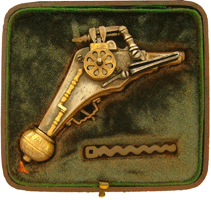
|
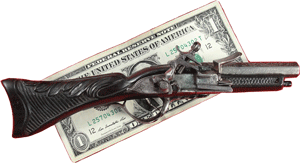
|
|
Wheel lock pistol, Germany, late 16th century. Case is 3.5 inches across and contains the pistol and the wrench used to wind the friction wheel.
|
Miquelet flintlock pistol dating to the mid 1700s, 8.75 inches long with a beautifully carved ebony stock.
|
Another reason for the making of miniature arms —that we can document—is as presentation pieces to important clients or royalty. Miniature arms can be viewed in many collections, such as Queen Victoria’s in the Victoria and Albert Museum.
Among the oldest functioning miniature firearms are wheel locks. Dating from the early to late 16th century, this complex mechanism used a spring-tensioned friction wheel to cause a spark when the “dog,” as the hammer was called, touched the spinning wheel. One of the best known miniature wheel lock makers was Michael Mann of Nuremburg.
|
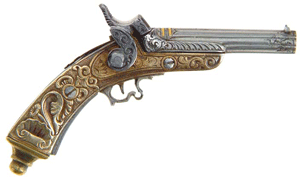
|
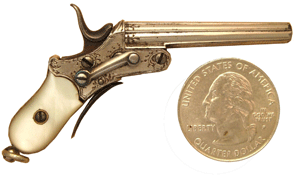
|
|
The deeply sculpted, engraved gold stock makes this antique Italian percussion pistol something special. The barrel, hammer and trigger are steel. Overall length is about 2.25 inches.
|
A nicely engraved, mid-to-late 1800s, German 3mm rimfire pistol with mother of pearl grips, 2.25 inches in length.
|
Flintlock arms, like the miniature Miquelet pistol illustrated, were popular guns for miniature makers. Their mechanisms, while still complex, were not as difficult to miniaturize as the wheel locks. Miquelet locks, snaplocks, snaphance, dog locks and French flintlocks are all variations of the flintlock. Antique miniature flintlocks will date from the late 1600s through the 1800s, concurrent with the popularity of each gun.
When it rained, the powder in the flash pans of flintlock pistols could easily become wet, making the guns useless. This problem was solved in 1820 with the invention of the percussion cap. The flash powder is contained in a small metal cup that, when placed snugly over a nipple at the breech of the barrel, was relatively weatherproof. In a short time, the percussion pistol became the dominant firearm design.
The illustrated gold stock Italian percussion pistol is an example of a unique miniature, probably based on a full-sized pistol. The deeply sculpted carving on the frame is exceptional, especially when you consider the scale at which it was done.
|
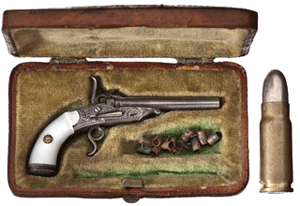
|
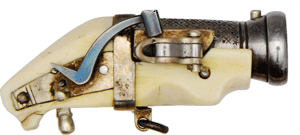
|
|
A miniature Japanese matchlock pistol, Edo Period (19th century) with ivory stock and iron parts; length 2.5 inches.
|
This miniature kipplaufpistole (tilt-down barrel pistol) is Czech and when auctioned, was dated “from around 1870.” The 2mm pinfire cartridges in the case, however, date it no earlier than the 1890s. It is marked on the barrel "NA PAMµTKU"; length 2 inches.
|
Up until the 1830s, most guns were what we call “muzzleloaders.” Powder was poured down the barrel, and a ball pushed down over the powder. The only variations were in the mechanisms that ignited the powder in the barrel.
Patented in 1831, the rimfire cartridge is one of the earliest metal cartridges. For the most part, it was used in low caliber pistols such as the Flobert, or parlor pistols, used for indoor target shooting. The German 3mm single shot rimfire pistol, illustrated, has the profile of many of these “parlor pistols,” but at less than 2.5 inches long, it is much smaller.
The matchlock pistol uses a smoldering cord, held by an arm, to ignite the powder in a flash pan. It is one of the oldest firearm designs. Most of the miniature matchlocks you will see, however, date from the 19th century. Due to its isolation from the West, the matchlock pistol remained common in Japan through the Edo Period (1603-1868), and most miniature matchlock pistols will date from that period.
Japanese matchlocks will have wood or ivory stocks and iron barrels, often with intricate inlays of silver or gold. The barrel, lock and stock are held together with a metal band. The example shown is a mere 2.5 inches long.
|
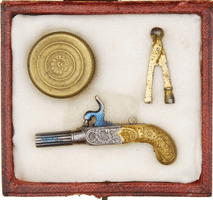
|
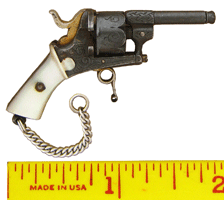
|
|
A 1mm French or Belgian percussion Muff pistol with engraved gold grips, with cased with Gevelot percussion cap tin, and combination bullet mold/barrel wrench, ca. 1890; 2 inches.
|
This was the most common of the 2mm open-top pinfire DA (double action) revolvers made in France and Belgium, ca.1880s-1940s; 2 inches.
|
In the mid-1800s, the pinfire cartridge was developed and made famous by Frenchman Casimir Lefauchaux. During the later years of the Civil War, due to the fact that most arms manufacturing was in the North and because of trade embargoes placed on the South, the pinfire pistol became the preferred firearm of soldiers from the South.
If you look closely at the photo of the cased miniature Czech pistol next to the full-size cartridge, you can see the tiny 2mm pinfire cartridges. They are about the size of a grain of rice.
In 1880, the French company Gevelot began manufacturing 2mm pinfire cartridges, as well as 1mm percussion caps. Muff pistol charms, similar to that shown cased with a brass tin of percussion caps and a combination bullet mold and barrel wrench tool, became all the rage. (Due to their small size, muff pistols were carried by women in their muffs during Victorian times, hence the name. Miniatures were usually worn hung on a chain like a charm, thus “muff pistol charm.”) Even Queen Victoria had one, and it can still be seen with a collection of her other miniature guns in the Victoria and Albert Museum.
Starting in the 1880s, muff pistols were manufactured in two varieties, with twist-off barrels and fixed barrels. The twist-off barrels allowed for a tight fit with the lead bullet, and although these tiny jewels are a mere two inches in length and use only a tiny 1mm percussion cap, they can propel a 2mm lead ball with enough force to penetrate about one inch of balsa wood.
|
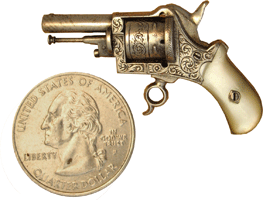
|
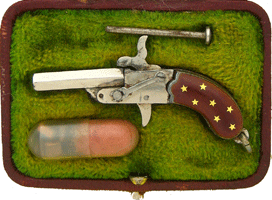
|
|
A much rarer Victor Bovy closed-top 2mm pinfire revolver, ca. 1884, engraved frame and mother of pearl grips; 1.5 inches.
|
This early Franz Pfannl 2mm pinfire Berloque pistol is unusual for its cloisonné grips. The pointed hammer and trigger date it to the 1890s; 1.75 inches.
|
During this same period, the French and Belgians began making 2mm pinfire pistols that were true DA (double action) revolvers. One pull of the trigger both cocked and released the hammer. The miniature DA revolver was sold from the 1880s through the 1940s. A 1939 Stoger gun catalog listed the DA for $35. At the time, a new car cost $400.
With the ready availability of the tiny 2mm cartridges came a rush of new designs. Revolvers came in several variations, the main difference being open-top versus closed-top designs for both pin and rimfire cartridges. A nice example of the 2mm closed-top pinfire revolver is the Victor Bovy, which was made in France, circa 1884. With its extensive engraving and mother of pearl grips, it is, at only 1.5 inches long, a wonder.
For collectors of 2mm pinfire pistols, Franz Pfannl of Austria is considered the father of the Berloque, or charm pistol. He is probably best known among firearms collectors as the designer of the Kolibri which was, at a mere 2 15/16 inches long, the smallest semi-automatic pistol ever manufactured.
Beginning in the late 1890s, he also designed and produced a long line of charm pistols. The most common is the Austrian- style 2mm pinfire with tilt down barrel and repousse grips. The cased piece shown has much rarer enameled grips with inset gold stars. This pistol was patented by Pfannl in Austria in 1899 and manufactured in his factory, in Krems, Austria, up to the close of his factory in 1943.
|
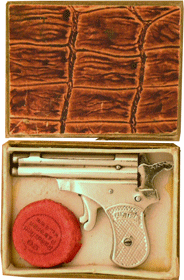
|
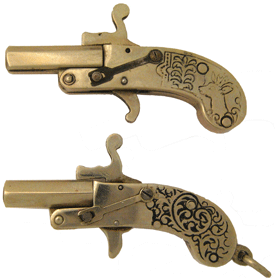
|
|
From 1920 to 1930, Pfannl manufactured this extremely rare double barrel 2mm rimfire; 2-1/16 inches.
|
These two 2mm Berloque charm pistols sold from the mid-1950s to the mid-1960s for $1.50 to $2. Today, they are $50 to $150 for a nice one.
|
Also shown is an extremely rare Pfannl design, a double barrel rimfire. It has “AUSTRIA” stamped on one grip and “KOBOLD” stamped on the other. It is boxed with a container of 2mm cartridges and has the typical faux alligator skin cardboard case.
Later charm pistol designs were manufactured by a variety of makers in Europe and after WWII, in Japan as well. These are more common and easily recognized by the grip designs stamped into the side of the pistols rather than being separate pieces attached to the gun. From the 1940s through the mid 1950s, these were often sold on display cards hung in local general stores and gas stations, as well as being marketed through tiny ads in the back of magazines such as Popular Mechanics.
And finally, we come to the reason contemporary miniature makers spend hours on a gun, often selling them for a price that works out to be average craftsman wages. The answer is simple: for the love it, for the challenge. It can be frustrating. It is maddening to have a part you've worked on for hours fly off only to be found weeks later when no longer needed. Many of today's makers are retired machinists, gunsmiths, jewelers or even artists.
Over the past 50 years, the fraternity of miniature gun makers has been a small one. Larry Smith, Ron Dewalt, Tom Weston, Stanley Blashack and Mike Barrett are names any miniature arms collector would recognize. One of the true master craftsmen of miniatures today is David Kucer. Working in a tiny 1/3 scale, his pieces are true masterpieces. Shown is his cased Remington pistol with all accessories. Note its tiny size in relation to the dime sitting on the case.
|
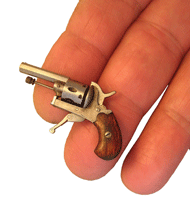
|
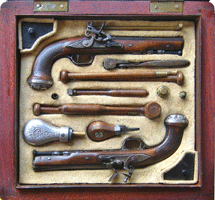
|
|
A tiny miniature Bulldog revolver made by Gordon Heasman of England.
|
A beautifully crafted set of 1798 Boutet dueling pistols made by Antonio Rincon of Columbia, 4 inches.
|
Also shown is a pair of miniature Delvigne derringers in 1/3 and 1/2 scale by myself and a cased set of 1798 Boutet dueling pistols made by South American maker Antonio Rincon.
The Miniature Arms Society of Collectors and Makers, is made up of members from around the world who share a passion for miniature arms. Their quarterly journal is packed with articles, photos and information. For further information, contact Alice McGinnis at mcginnr@chorus.net.
|
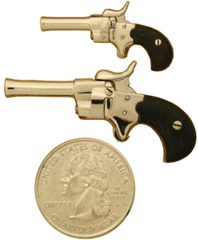
|
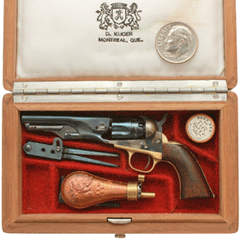
|
|
Tiny 1/4 to 1/2 scale miniatures of a French Delvigne derringer, both fire the 2mm pinfire cartridge. Made by Bob Urso.
|
A 1/3 scale Remington revolver, cased with all accessories by master maker David Kucer of Montreal, Canada.
|
Some contemporary miniature arms makers and dealers include:
*Wayne Driskill Miniatures: a major dealer in antique and contemporary miniature arms, with a comprehensive website at
www.waynedriskillminiatures.com.
*Piccolo Miniatures: my website (www.boburso.com) with information about my book, The Tiniest Guns, as well as a complete
list of my miniature 2mm pinfire pistols and prices.
*David Kucer miniatures, www.kucers.com.
*Pinfire Guns (www.pinfireguns.com): a source for 2mm pistols and ammunition.
*Menefe Collectable Miniature Firearms: www.miniaturefirearm.com.
----------------------------------------------
Bob Urso is a retired professor of art, having taught design, computer graphics and drawing at the university level for 40 years. For the past 15 years, he has edited the Miniature Arms Journal and been a maker and collector of miniature arms. He is also the author of The Tiniest Gun, the only reference book for collectors of miniature 2mm pinfire and rimfire pistols. His website is www.boburso.com.
Bibliography:
Brown, Hall, Morrow, Art of Miniature Firearms, Miniature Arms Society 1999. A great book loaded with images of impressive miniatures. Available from the Miniature Arms Society, mcginnr@chorus.net.
Urso, Bob, The Tiniest Guns, a catalog for collectors of 2mm pinfire and rimfire miniatures; 4th edition 2014, available at www.boburso.com
Winant, L., Firearms Curiosa, a full chapter on miniature pistols, Bonanza Books, New York, 1955.
Lindsay, M., Miniature Arms, Winchester Press, New York, 1970.
Cooper, J., Belgian Miniature Firearms of the Nineteenth Century, Wilson Hunt, Dorset, England, 1996.
|